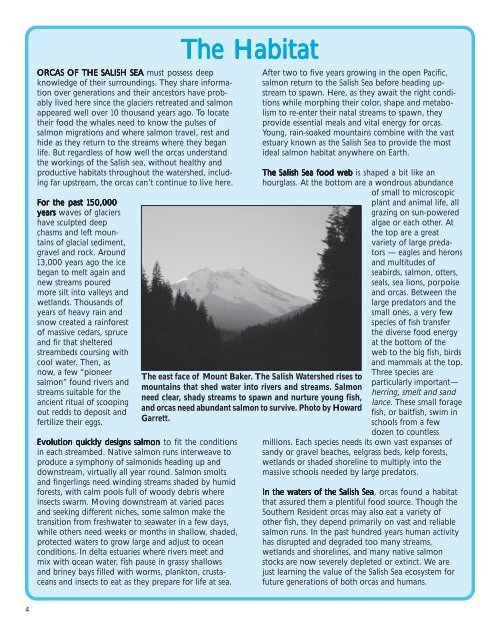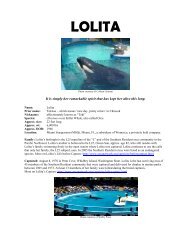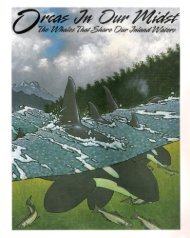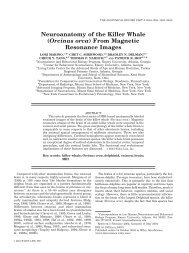Create successful ePaper yourself
Turn your PDF publications into a flip-book with our unique Google optimized e-Paper software.
ORCAS OF THE SALISH SEA must possess deepknowledge of their surroundings. They share informationover generations and their ancestors have probablylived here since the glaciers retreated and salmonappeared well over 10 thousand years ago. To locatetheir food the whales need to know the pulses ofsalmon migrations and where salmon travel, rest andhide as they return to the streams where they beganlife. But regardless of how well the orcas understandthe workings of the Salish sea, without healthy andproductive habitats throughout the watershed, includingfar upstream, the orcas can’t continue to live here.For the past 150,000years waves of glaciershave sculpted deepchasms and left mountainsof glacial sediment,gravel and rock. Around13,000 years ago the icebegan to melt again andnew streams pouredmore silt into valleys andwetlands. Thousands ofyears of heavy rain andsnow created a rainforestof massive cedars, spruceand fir that shelteredstreambeds coursing withcool water. Then, asnow, a few “pioneersalmon” found rivers andstreams suitable for theancient ritual of scoopingout redds to deposit andfertilize their eggs.Evolution quickly designs salmon to fit the conditionsin each streambed. Native salmon runs interweave toproduce a symphony of salmonids heading up anddownstream, virtually all year round. Salmon smoltsand fingerlings need winding streams shaded by humidforests, with calm pools full of woody debris whereinsects swarm. Moving downstream at varied pacesand seeking different niches, some salmon make thetransition from freshwater to seawater in a few days,while others need weeks or months in shallow, shaded,protected waters to grow large and adjust to oceanconditions. <strong>In</strong> delta estuaries where rivers meet andmix with ocean water, fish pause in grassy shallowsand briney bays filled with worms, plankton, crustaceansand insects to eat as they prepare for life at sea.The HabitatAfter two to five years growing in the open Pacific,salmon return to the Salish Sea before heading upstreamto spawn. Here, as they await the right conditionswhile morphing their color, shape and metabolismto re-enter their natal streams to spawn, theyprovide essential meals and vital energy for orcas.Young, rain-soaked mountains combine with the vastestuary known as the Salish Sea to provide the mostideal salmon habitat anywhere on Earth.The Salish Sea food web is shaped a bit like anhourglass. At the bottom are a wondrous abundanceof small to microscopicplant and animal life, allgrazing on sun-poweredalgae or each other. Atthe top are a greatvariety of large predators— eagles and heronsand multitudes ofseabirds, salmon, otters,seals, sea lions, porpoiseand orcas. Between thelarge predators and thesmall ones, a very fewspecies of fish transferthe diverse food energyat the bottom of theweb to the big fish, birdsand mammals at the top.Three species areparticularly important—herring, smelt and sandlance. These small foragefish, or baitfish, swim inschools from a fewdozen to countlessmillions. Each species needs its own vast expanses ofsandy or gravel beaches, eelgrass beds, kelp forests,wetlands or shaded shoreline to multiply into themassive schools needed by large predators.The east face of Mount Baker. The Salish Watershed rises tomountains that shed water into rivers and streams. Salmonneed clear, shady streams to spawn and nurture young fish,and orcas need abundant salmon to survive. Photo by HowardGarrett.<strong>In</strong> the waters of the Salish Sea, orcas found a habitatthat assured them a plentiful food source. Though theSouthern Resident orcas may also eat a variety ofother fish, they depend primarily on vast and reliablesalmon runs. <strong>In</strong> the past hundred years human activityhas disrupted and degraded too many streams,wetlands and shorelines, and many native salmonstocks are now severely depleted or extinct. We arejust learning the value of the Salish Sea ecosystem forfuture generations of both orcas and humans.4







